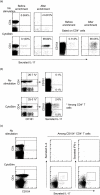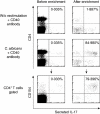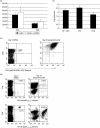Rapid detection, enrichment and propagation of specific T cell subsets based on cytokine secretion
- PMID: 20964638
- PMCID: PMC3010906
- DOI: 10.1111/j.1365-2249.2010.04261.x
Rapid detection, enrichment and propagation of specific T cell subsets based on cytokine secretion
Abstract
T cell lines with defined cytokine profiles are an invaluable tool for assessing the control of immune responses both in vitro and in vivo. Production of such cell lines can be complex and time-consuming. Here we present a powerful technique to assay the cytokines produced by T cells activated polyclonally or with specific antigens. This paper presents a detailed methodology for the identification and isolation of cytokine-producing T cells activated with the artificial superantigen, CytoStim, or viral and fungal antigens. These cells can be analysed for different cytokines simultaneously, or cultured further to rapidly establish T cell lines making known cytokine types. We highlight the enumeration, isolation and phenotype of interleukin-17-producing T cells, and the rapid generation of virus-specific Th1 T cell lines.
© 2010 The Authors. Clinical and Experimental Immunology © 2010 British Society for Immunology.
Figures



 : Unstimulated controls.
: Unstimulated controls.


References
-
- Mosmann TR, Cherwinski H, Bond MW, et al. Two types of murine helper T cell clone. I. Definition according to profiles of lymphokine activities and secreted proteins. J Immunol. 1986;136:2348–57. - PubMed
-
- Peggs KS, Verfuerth S, Pizzey A, et al. Cytomegalovirus-specific T cell immunotherapy promotes restoration of durable functional antiviral immunity following allogeneic stem cell transplantation. Clin Infect Dis. 2009;49:1851–60. - PubMed
Publication types
MeSH terms
Substances
LinkOut - more resources
Full Text Sources
Other Literature Sources

